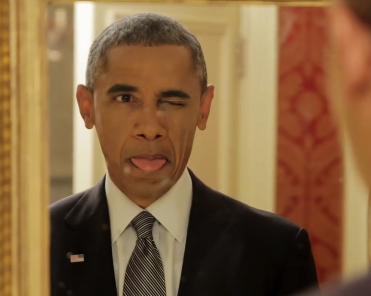 Print
Print  PDF
PDFObama stirred up a lot of attention with his BuzzFeed video Things Everybody Does but Doesn’t Talk About. Attention in the political world, by definition, means controversy. The BuzzFeed video shows Obama mugging about, taking selfies with a selfie stick, playing air basketball and acting out several other Internet memes (e.g., YOLO, “Thanks Obama”) in an effort to get young people to visit HealthCare.gov and sign up for health insurance. For leaders, there is a difficult balance between what’s human and relatable on the one hand and what engenders the confidence to inspire followers on the other. Did this strike the right balance?
 BuzzFeed via Facebook
BuzzFeed via Facebook
The video, like the Obama’s interview last year with comedian Zach Galifianakis on Between Two Ferns is clearly targeting a young demographic. Over 50% of BuzzFeed’s audience is under 30 and they grew up consuming information in a different way than the generations before them. They are active rather than passive participants. As we can all testify, there’s no shortage of information out there. Getting a message across to a generation that knows they have choice in what they consume is hard work. It’s no longer simply information distribution; messaging has to deliver some value in the eyes of the receiver. In other words, it has to be something people want to watch. Health insurance is not a particularly entertaining topic. And while getting health insurance may ultimately value deliver, most messages about it don’t.
The Obama video has received over 24 million views the last time I looked—pretty good for a message about health insurance. The controversy around the video helps its spreadability. The video is definitely getting viewed and will likely raise awareness and spike enrollments. It doesn’t help with the myriad of confusion, misperceptions and difficulties of dealing with health insurance, which ranks right up there with trying to understand tax returns, but you can’t have everything. At this juncture, enrollment numbers are what matter. That success may come at the price.
The video is potentially disruptive. Not because of the politicians squawking at each other on both sides, but in how it impacts the American psyche. Obama personally has little to lose. He is in his second term and spending his political and social capital right now to give the Affordable Care Act some legs is likely a big priority in establishing his legacy.
Obama’s health insurance video targeted the uninsured, under-30s but what message did it send to everyone else?
As President, there is an awkward balancing act between selling domestic programs and maintaining a global profile. On the one hand, if you want to talk to people under 30, you have to go where they are—and that’s places like BuzzFeed, YouTube and the Daily Show. For that audience, it’s about content creation, not political rhetoric. In that sense the video was created to be funny, connect on a human level (things we ALL do), and humanize the President, by turning him into a friend, not an important special guy. In those ways, it was a success (although I would have preferred a clean mirror.) But even remarks like that drive people to view the video. Using someone besides Obama in the video, whether celebrity, politico or actor, might have been humorous, but not worth 24 million and counting views. It’s the juxtaposition of our Commander in Chief mugging in front of a mirror and using a selfie stick that create the emotional hook necessary to get people’s attention. We often don’t see our political leaders in this light—at least not by their intention.
But the question remains as to whether this is a good thing globally? Is Obama sacrificing US political capital for personal political capital? Does this type of thing reverberate around the world and influence the dignity of the office, the assumptions made by other world leaders and the United States’ effectiveness in the global political chess games? To me, it also raises a question closer to home. Past the initial amusement, do we want to see our President this way? How human do we want our leaders to be? There is a fine line between what’s human and relatable on the one hand and what inspires confidence on the other. Leadership requires trust and loyalty, for sure, but it’s also about demonstrating your character, judgment, strength and capacity to take charge. It is these characteristics that make people feel safe in tough times. The psychologist George Gerbner wrote extensively about the mean world syndrome—how seeing lots of violence in the news made people feel their world was less safe than it actually was. Is there a cost here in terms of psychological comfort? For some, the humor and humanity may be reassuring and show that Obama has the confidence to make fun of himself, but for many it may undermine their sense of security. This isn’t something that shows up in the editorials. This is something that, like heart disease, is a silent killer. It shows up in people’s anxiety levels, in their flexibility and ability to adapt to change and the predisposition to conflict with others. How do we interpret terrorist actions if we lack confidence in the decisiveness of our leadership? People who don’t feel safe do some really awful things. Did Obama strike the right balance? Maybe yes, maybe no, depending on your point of view, but those are the questions that I’d want to raise if I were at the table.
Previously posted in Psychology Today.

